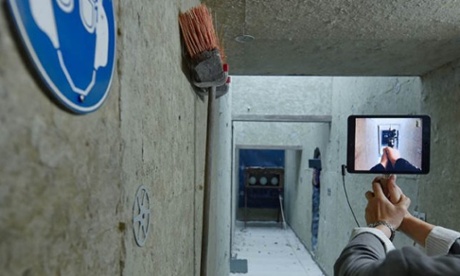
Grasping an iPad mini, headphones glued to my ears, I reach out and open the door marked number five, and step into the Situation Rooms – a complex of interlinked chambers, each with different and numerous stories, that I will navigate for the next 70 minutes, obeying on-screen commands and visual prompts. I don costumes, hoist flags, smuggle USB sticks, slurp borscht at well-worn kitchen tables. And live the stories of 10 people – real people, many of whom appear on camera here – whose lives have been touched by the international arms trade.
I’m still not entirely sure how I should categorise this remarkable experience – it’s theatre with the audience as actors; journalism with the consumer interacting directly with the story; a video game where the screen bleeds into real and constructed worlds. But above all it is utterly absorbing – for more than an hour you are so busy living this piece of extraordinary art that that you do really become it.
In part that is because Rimini Protokoll, the company behind this project, seem determined to stretch their audience to their limits. It is an initially disorientating experience – plunged into an unfamiliar and ever-changing environment, trying to match the POV on your iPad with the scene before you, and follow instructions. That would be enough to be going on with, but there are another 19 people let loose in the Situation Rooms at the same time as you.
This is where the show is particularly impressive: the iPad prompts you to interact with other characters as you meet them; as you cycle through 10 of a possible 20 characters, you might find yourself on the other side of that relationship, giving new insights on what you first witnessed, and how it joins up with other stories. You become the people you once observed, realize that things might not be as they seem.
Gathered as an audience of 20 at the beginning and end of the Situation Rooms, you are otherwise contained in your own world entirely aside from these brief interactions – your experience of the work much closer to playing a video game than watching a theatrical work. The audience is not so much sharing in this dramatic experience, but facilitating each others’ separate explorations of it. (Whether this is a desirable outcome, I’m not convinced).
The work is intricately and cleverly plotted; the impact of your actions, or a different reading of them, often obscured until several steps on. You can feel strongly about a story as you are living it, only to have your viewpoint challenged by others along the way.
Whether you have enough time to process everything that’s going on is debatable. I wondered at times whether the balance between interactivity and storytelling was a bit out; the impact of these important stories reduced because one is given so little time to really consider them. They become another element in the experience, rather than the driving force behind it.
But challenging your audience, making them active and involved in storytelling, has to be a good thing. Situation Rooms is innovative and exciting work that asks questions of the way theatre is both presented and consumed.

